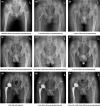Slipped capital femoral epiphysis in an adolescent with congenital adrenal hyperplasia: A case report
- PMID: 38947535
- PMCID: PMC11213715
- DOI: 10.1002/ccr3.9131
Slipped capital femoral epiphysis in an adolescent with congenital adrenal hyperplasia: A case report
Abstract
In previous reports, hypothyroidism, hypopituitrism, and hypogonadism were common endocrine causes of SCFE, but this is the first time that congenital adrenal hyperplasia has been observed. As such, patients who have undergone long-term endocrine treatment for congenital adrenal hyperplasia could potentially be subjected to a higher risk for SCFE.
Keywords: adrenal hyperplasia; congenital; epiphyses; slipped.
© 2024 The Author(s). Clinical Case Reports published by John Wiley & Sons Ltd.
Conflict of interest statement
All authors declare that they have no conflict of interest.
Figures







Similar articles
-
A new compound heterozygous mutation in a female with 17α-hydroxylase/17,20-lyase deficiency, slipped capital femoral epiphysis, and adrenal myelolipoma.Gynecol Endocrinol. 2019 May;35(5):385-389. doi: 10.1080/09513590.2018.1540576. Epub 2019 Jan 7. Gynecol Endocrinol. 2019. PMID: 30614301
-
Prepubertal onset of slipped capital femoral epiphysis associated with hypothyroidism: a case report and literature review.BMC Endocr Disord. 2017 Sep 18;17(1):59. doi: 10.1186/s12902-017-0210-6. BMC Endocr Disord. 2017. PMID: 28923047 Free PMC article. Review.
-
Association of Slipped Capital Femoral Epiphysis With Panhypopituitarism Due to Pituitary Macroadenoma: A Case Report.J Investig Med High Impact Case Rep. 2021 Jan-Dec;9:2324709621999956. doi: 10.1177/2324709621999956. J Investig Med High Impact Case Rep. 2021. PMID: 33783256 Free PMC article.
-
Review of slipped capital femoral epiphysis associated with endocrine disease.J Pediatr Orthop. 1993 Sep-Oct;13(5):610-4. J Pediatr Orthop. 1993. PMID: 8376562 Review.
-
Primary Hypothyroidism Presenting as Slipped Capital Femoral Epiphysis in an Adult Patient : A Case Report and Review of Literature.J Orthop Case Rep. 2021 Nov;11(11):16-18. doi: 10.13107/jocr.2021.v11.i11.2496. J Orthop Case Rep. 2021. PMID: 35415117 Free PMC article.
References
-
- Peck DM, Voss LM, Voss TT. Slipped capital femoral epiphysis: diagnosis and management. Am Fam Physician. 2017;95:779‐784. - PubMed
-
- Witbreuk M, van Kemenade FJ, van der Sluijs JA, Jansma EP, Rotteveel J, van Royen BJ. Slipped capital femoral epiphysis and its association with endocrine, metabolic and chronic diseases: a systematic review of the literature. J Child Orthop. 2013;7:213‐223. doi:10.1007/s11832-013-0493-8 - DOI - PMC - PubMed
Publication types
LinkOut - more resources
Full Text Sources
Research Materials

